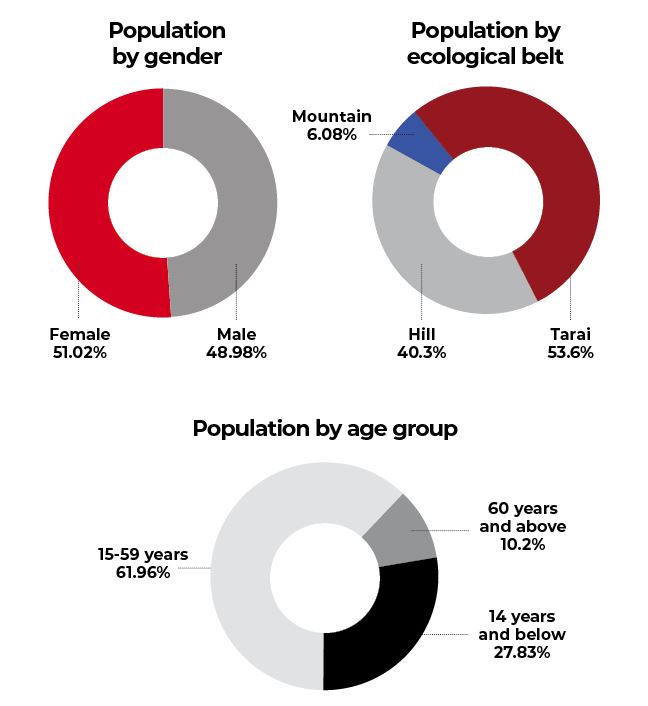Nepal’s demographic dividend
A year-and-half after the Nepal’s 2021 National Population and Housing Census was conducted, the final results were finally published on 24 March.
Nepal’s population has crossed 29.1 million but annual growth has slowed to 0.92% from 1.35% ten years ago. The gender ratio is even more skewed, with only 95.6 males per 100 females. There are now 6.6 million households across the country, an increase of 23% over the decade, which means more nuclear families.
The population pyramid now shows fewer children, a youth bulge, and greater numbers of elderly. Ten years ago, 35% of the population was below 14, that proportion had gone down to 28%. Meanwhile, the number of people older than 60 has climbed to 10% from 8%.

“The decrease in the population growth rate is characteristic of the state’s efforts to drive socio-economic development, and is similar to global population trends,” says Keshab Prasad Adhikari at the Central Department of Population Studies at Tribhuvan University. “What the government and related agencies need to do now is formulate programs and policies so that the annual population growth rate does not go down any further. And if it does, not less than 0.5%.”
Prof Adhikari finds it alarming that the number of female births and the female population under 14 is lower than males. Which shows a cultural preference for boys, even though women tend to live longer.
More than 66% of Nepalis now live in urban areas, but that is only because of the new demarcation of municipalities. Even so, there is a mass migration of the mountain population from the mountains to city hubs in the plains. Nearly 54% of Nepalis now live in the Tarai, while only 6% remain in the high mountain districts.
Read also: Counting on Nepal, Editorial
“Transmigration to urbanised spaces and to the plains has been haphazard. And in many cases, areas that do not need to be have been unnecessarily assigned as urban,” adds Adhikari.
The 2011 census had shown that 64% of total households used biomass for cooking, and this has gone down to 51%, mainly because 44% of homes use LPG. Access to piped drinking water has gone up to 57% in 2021 from 48% a decade ago.
Almost 73% of Nepali households have smartphones while 37% have access to internet services, and nearly half of households own a television. Meanwhile, 27% of the households own a motorcycle, with only 3% having a four-wheeler.
Read also: Everybody counts in Nepal, Shristi Karki

Nepal’s literacy rate has gone up to 76%, up from 66% in 2011, with female literacy increasing from 57% to 70%. However, only 19% of young Nepalis opt for higher studies after completing school.
The census was conducted using Computer Assisted Personal Interviewing (CAPI) techniques with tablets to collect data in Kathmandu Valley, using cartographic GIS maps to better reach enumeration areas, and allocating a separate data processing centre within the CBS premises.
Chief Statistician Ram Prasad Thapaliya at the National Statistics Office writes in the final report: ‘There is enormous demand for a high granularity dataset in Nepal’s new context of decentralisation in social and economic planning, provision of social services and resource allocation. The census process and results were designed and managed to generate comprehensive demographic social and economic data in consultation with stakeholders.’
However, there are questions about the precision of the census data. For instance, Nepal’s absentee population is recorded as crossing 2.1 million, but this appears to be a gross under-estimate considering that there are about 2 million Nepalis in the Gulf states alone, and it does not include Nepalis in India and students in Australia, Japan or Canada.
Read also: Nepal holding census despite Covid and boycott, Shristi Karki

The results also have not disaggregated the data by ethnicity and religion even though those questions were included in the census. The government could have considered those to be too sensitive in Nepal’s present context.
Hem Raj Regmi of the National Statistics Office (NSO) says, “There was confusion about some respondents declaring unlisted religion and ethnic affiliations which is why we have kept back those figures.”
But the RPP-N’s Kamal Thapa has accused the government of deliberately hiding figures that would have shown a growing Christian population due to proselytisation.
The Central Bureau of Statistics (CBS), now the National Statistics Office, established 7 provincial, 87 district and 349 Local Census Offices to conduct the census, deploying 8,545 supervisors and 35,657 enumerators with local knowledge to collect data across Nepal. The census was conducted over a fortnight from 11-25 November 2021.
Read also: Remembering the 1961 census, Bhairab Risal
writer
Shristi Karki is a correspondent with Nepali Times. She joined Nepali Times as an intern in 2020, becoming a part of the newsroom full-time after graduating from Kathmandu University School of Arts. Karki has reported on politics, current affairs, art and culture.




